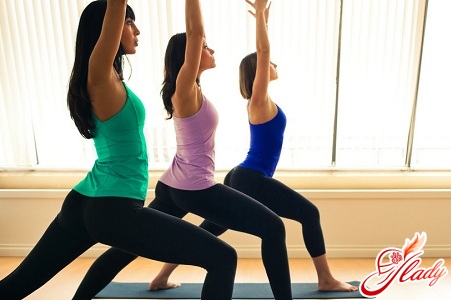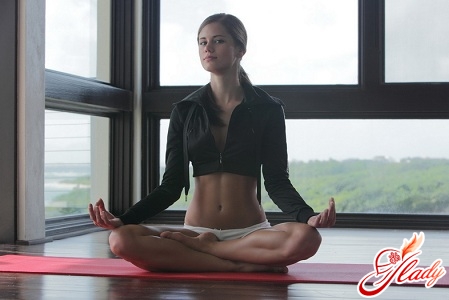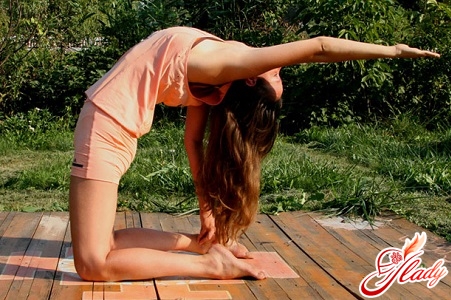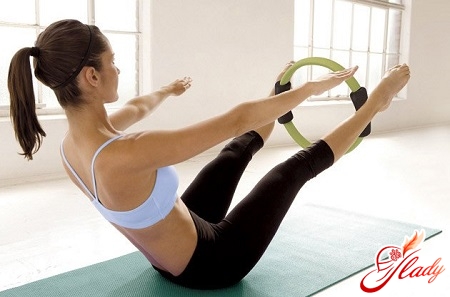 Over the past few years, yoga has becomeis incredibly popular among girls in our country. It has replaced the usual and already boring types of physical exercise: Pilates, cardio striptease and aqua aerobics. Yoga for beginners - exercises aimed at stretching muscles, strengthening the spine, general health improvement of the body and preparing it for mastering more complex asanas, as well as developing iron willpower. Yoga cannot be considered exclusively a way of training the body - it helps to improve not only the physical shell, but also the mind. Therefore, the initial stage of yoga training involves not only performing basic poses, but also achieving clarity of mind and consciousness by following a certain list of rules.
Over the past few years, yoga has becomeis incredibly popular among girls in our country. It has replaced the usual and already boring types of physical exercise: Pilates, cardio striptease and aqua aerobics. Yoga for beginners - exercises aimed at stretching muscles, strengthening the spine, general health improvement of the body and preparing it for mastering more complex asanas, as well as developing iron willpower. Yoga cannot be considered exclusively a way of training the body - it helps to improve not only the physical shell, but also the mind. Therefore, the initial stage of yoga training involves not only performing basic poses, but also achieving clarity of mind and consciousness by following a certain list of rules.
What is yoga?
It is rash to consider yoga a religion.Undoubtedly, it arose on the basis of religious and philosophical movements, but in itself it is not considered a religion. The famous philosopher Patanjali, who lived in ancient India, was the first to summarize the knowledge of his people about physical culture and spiritual practices. In the third century BC, he wrote the first textbook on yoga - the so-called "Yoga Sutra". It immortalized the basic principles of self-development and hardening of the mind and body, ways to achieve higher enlightenment and descriptions of the first asanas successfully practiced by supporters of Hinduism. The book was reproduced by Patanjali's followers after his death. Yoga schools began to open all over India, whose students tried to achieve energetic euphoria - "samadhi" with the help of asanas and meditation. This is a state of absolute satisfaction, when a person is able to abstract not only from the problems around him, but even drown out pain with an effort of will. For a long time, this mental "trance" was considered an ordinary myth to attract people. However, in the 18th century, archaeological excavations were carried out on the territory of Ancient India, during which two coffins with the bodies of monks buried more than half a century ago were pulled out from under the ground. There was not even a shadow of decomposition on either of them - so pure mentally and physically did they leave this world.
The first level of yoga: "yama" - preparation for performing asanas
- Rejection of bad habits
Two to three weeks before the start of classes, stopfrom cigarettes and alcohol. In a few days, your breathing will become even, headaches will disappear, and you will finally stop suffering from insomnia. The true teaching of yoga prohibits the use of tobacco and alcohol, even in small quantities. How can a yogi conquer his body and subdue his willpower if he is dependent on bad habits? It turns out that yoga classes are an excellent reason to quit smoking and finally stop “running away” from problems with a glass of wine.
- Positive thinking
Learn to see the positive in everything.A person who looks at the world around him through the eyes of a pessimist is unable to understand the joy of strengthening the body shell by staying in an uncomfortable position for a long time. Did your boss unfairly promote your colleague? This is a great reason for self-improvement - if you show yourself from the best side, you too will get the chair of the department manager! Did you try to dye your hair yourself, but were not satisfied with the result? But pamper yourself and visit a beauty salon to look even more impressive and beautiful.
- Ability to listen to oneself
It is necessary to feel the needs of one's ownof the body. Practical yoga classes will not give the desired result until you learn to listen to yourself. If you sleep 8 hours a day, but still feel exhausted by lunchtime, extend the pleasure for another hour and your health will improve. Pimples pop up on your face every now and then, and your stomach asks for light food? Give up your favorite nuggets, country potatoes and cola - your skin will clear up, and your nightly heartburn will disappear without a trace.
- Full control over yourself
Be patient and self-controlled.Yoga teaches endurance, the ability to tolerate inconveniences and overcome them with dignity, without losing your mind. This practice will quickly bore you if you are restless, quickly and enthusiastically rush to conquer new heights, and then just as easily give up on the goal that you so passionately desired so recently. On the path of life, you will expect not only dizzying ups, but also no less rapid falls, but this is not a reason to give up on your dream. The same is true for yoga: if something does not work out the first time, take a rest and try again. If you are insulted, just mentally wish the person well. Anger will only ruin your own nerve cells, and will not bring any benefit.
- Independence from external factors
Don't let your mood depend onweather conditions, a cup of coffee, a headache or criticism from an elderly neighbor. Gain complete independence from your feelings. Often girls justify their refusal to attend classes by the fact that they are tired, and at home they also have things to do, children and a hungry husband. Over time, laziness will develop, and you will completely abandon yoga. When performing asanas, abstract yourself from the "wishes" of a neighbor in a traffic jam, PMS and a quarrel with the boss.
- Concentration
Learn to concentrate.For example, on an object, your own feelings or an interesting book. This quality will be useful to you not only during yoga classes - by regularly doing the exercises, you yourself will be surprised to notice that you have learned not to be distracted by details during the work process.
The second level is meditation or dhyana
Anyone who wants to practice yoga seriously,must first learn the art of meditation. Meditation is immersion in yourself, expansion of consciousness, a way to establish control over thoughts, emotions and feelings. In addition, it is an excellent means of training concentration. It will help alleviate the symptoms of a debilitating illness, relax after a hard day at work and find peace after the loss of a loved one. Most meditation practices will be an excellent "introduction" to yoga. First, get comfortable. The myth that you can only meditate while sitting in the "lotus" position has nothing to do with reality. Sit on the floor if you are comfortable there, sit on a soft pillow or chair. How can you relax if you are in an uncomfortable position with numb legs and an aching back? If you are chilly, put on a sweatshirt or a thin sweater. Comfort is the main rule when choosing not only a position, but also clothes. The best background for meditation will be slow music with ethnic motives. To calm down and make it easier to count the mantras you have pronounced, take a rosary in your hands. Plastic "beads" sold in markets and souvenir shops should definitely not be used. The cold of a natural stone, fingered in your hands, sobers a person, and "stroking" the rough surface of garnet, malachite or Tibetan yak bone calms and sets you up for meditation. Sit in a comfortable position. Close your eyes and slowly count to 10. The room you are in should be completely silent so that nothing distracts you from the action. Listen to yourself, your body, your thoughts. Inhaling deeply, imagine how oxygen penetrates the blood, and it runs through the veins, breathing in life and warming your physical body. Think about what the air in your apartment smells like? The perfume of your beloved man, delicious soup steaming on the stove or positive emotions? Feel the touch of clothes on your soft skin. What sensation do you have from contact with silk, wool, linen? Then focus on the work of your internal organs. Start rocking back and forth, focusing on the rhythm of your heartbeat. Concentrate on the thought that is currently bothering you the most. What are you thinking about? Try to evaluate your behavior and actions from the outside, as if they do not belong to you at all. Do not be afraid to admit your own mistakes - they strengthen the human spirit, make it stronger. Calm down and think about the fact that in a few days or weeks your problem will most likely seem funny and far-fetched to you. Sit in silence for a few more minutes. Slowly open your eyes and stand up. Now you can begin to do the exercises themselves.
Complex for beginners
- Vajrasana
Start with the diamond pose.Kneel on a small cushion lying on the floor. Sit with your buttocks on your heels, keeping your back straight. Try to make sure your knees, ankles and feet are in maximum contact with the surface of the cushion. Raise your head up, breathe deeply. Stay in this pose for 1.5-2 minutes, no more.
- Lower yogic breathing
After resting for 10-20 seconds, sit back down."Vajrasana". Try to breathe with your stomach. When inhaling, try to "push" the air with your abdominal muscles, alternately drawing them in and relaxing them. When inhaling, keep your abs as tense as possible.
- Shavasana
The next pose is for relaxation inbetween more complex and energy-intensive exercises. Prepare a thin mat for it in advance. Lie on your back, place your arms along your body with your palms facing up, bend your knees or stretch your legs. Feel how your body has relaxed in just a few seconds, all muscle groups are resting. Watch your breathing - when performing "Shavasana" it should be calm and even, not intermittent. Lie in this pose for 8-10 minutes with your eyes closed to replenish your loss of strength.
- "Roller"
With your eyes open, sit up and hug your knees tightly.with your hands or clasp your fingers together. Straighten your spine, as if stretching into a string. Feeling its tension, slowly relax your hands and lie on your back. A couple of deep breaths, then repeat the exercise. Do this 10 times.
- Tadasana
The next pose, Tadasana, helps relievemuscle tension. Stand on the mat, with your heels touching. Make sure that not only your spine, but also your shoulders are straight and not skewed while doing the “mountain pose”. Take a deep breath and hold it for 5-10 seconds, straining your abdominal muscles. Exhale sharply and relax. The break between repetitions of this asana is 2 seconds. If you suffer from a runny nose, try replacing this exercise with “Bhastrika”. The starting pose is similar to “Tadasana”. Take quick breaths in and out at the following pace: 15 breaths in and out for 2-3 seconds, then 2 deep breaths for 5-6 seconds. Repeat 3-4 times daily.
Tips for beginners
- Doubt? Ask for advice!
Don't hesitate to consult with more experienced people.practitioners and use their experience. Watch training videos on the Internet, read magazines dedicated to yoga, and communicate on specialized forums. Of course, such "consultations" cannot be compared with instructions at a yoga school. However, if you currently do not have enough time and money to attend training, communication with "advanced" practitioners will help you find answers to your questions.
- Set a clear goal and follow it
What do you want to achieve by doing yoga?If you want to learn the full depth of yoga philosophy, practice daily. Did you decide to practice because you heard that yoga is an excellent preventative measure against colds? Then one or two classes a week will be enough.
- Do yoga on an empty stomach
Performing poses immediately after eating is not recommended.The ideal time for classes is early in the morning, when your stomach is still empty. It is permissible to practice asanas approximately one and a half to two hours after eating. Before training, if you are very hungry, you can drink a glass of kefir or warm green tea. Today, many representatives of the fair sex begin to practice yoga, paying tribute to fickle fashion. However, classes “through force” will not bring positive results, since they do not bring true pleasure. We recommend reading:









